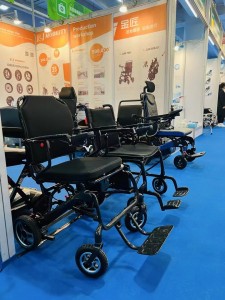4 Development Trends and Future Prospects of Electric Wheelchairs
While manual wheelchairs are budget-friendly, they require significant physical effort and offer limited safety features. Many people urgently need electric wheelchairs to ease their daily activities, reduce physical strain, and enhance their quality of life. As research in intelligent wheelchair technology advances, these innovations promise to lessen social burdens and boost societal development. Let’s explore the key development trends shaping the future of electric wheelchairs.
1. Advancing Towards Intelligence
With rapid advancements in science and technology, integrating intelligence is an inevitable direction for electric wheelchairs. Future designs will incorporate cutting-edge smart technologies and more intuitive human-machine interfaces. Features like voice, eye, and even consciousness-based controls are being developed, alongside automatic driving capabilities. Furthermore, integration with smartphones will empower users to operate their wheelchairs independently, eliminating the need for constant assistance.
2. Emphasis on Human-Centric Design
Electric wheelchairs are primarily intended for the elderly and individuals with disabilities, making humanized design a crucial consideration. These wheelchairs should cater to varying levels of disability and psychological needs. Simplifying complex control mechanisms and minimizing operational steps are essential to make them more user-friendly. Additionally, design elements should evoke positive emotions, focusing on aspects like color schemes, seat cushion materials, and adjustable backrest angles. Ergonomics and comfort are vital to ensure a better user experience.
3. Modular Manufacturing Approach
To thrive in the market, electric wheelchairs need to be developed with a modular production model. This approach involves combining essential modules with various functional modules. Users can customize their wheelchair by selecting the appropriate modules based on their unique needs. Modular production not only addresses the diverse requirements of different consumer groups but also aids manufacturers in managing production costs and ensuring product quality. It streamlines the manufacturing process and simplifies after-sales service, offering greater flexibility and efficiency.
4. Market Commercialization
Electric wheelchairs are evolving from being niche products showcased in research labs or tech expos to mainstream consumer items. Much like how smartphones became a ubiquitous part of everyday life, intelligent wheelchairs are expected to follow a similar path. The market will feature a wide range of options, with various brands, price points, styles, and features, making them as accessible as other common consumer electronics.
These trends highlight the exciting future of electric wheelchairs, making them more advanced, user-friendly, and accessible. If you’re interested in learning more, feel free to reach out to us or visit our website at www.jj-mobility.com.
Post time: Nov-08-2024


